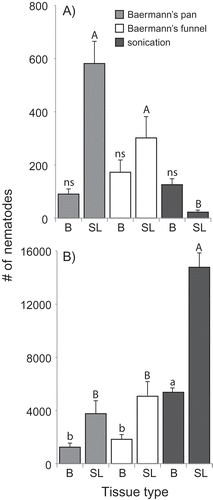Figures & data
Fig. 1 Efficacy of three different methods for the extraction of Ditylenchus dipsaci from four soil types expressed as the percentage of recovery from artificially infested samples. The experiment was carried out in 2017 (A) and 2018 (B). Soil types are: C = silty clay; L = loam; M = muck; S = sand. Error bars represent the standard errors of 10 replicates. Letters above each bar signify statistical differences according to Dunn test.

Fig. 2 Number of nematodes extracted from garlic bulbs or from stems and leaves using three different extraction methods. The experiment was carried out in 2017 (A) and 2018 (B). Tissue types are: B = bulbs; SL = stems and leaves. Extractions were done on 30 g of garlic bulbs or 13 g of stems and leaves cut in small pieces from a homogenous pool of naturally infested plants. Error bars represent the standard errors of 10 replicates. Letters above each bar signify statistical differences according to Dunn test.

